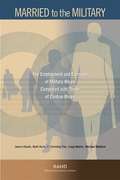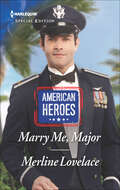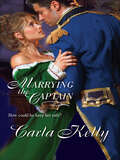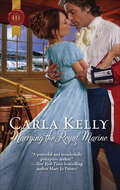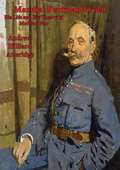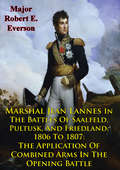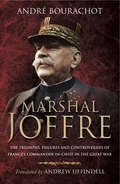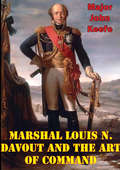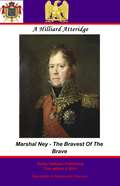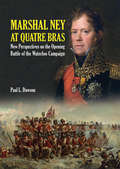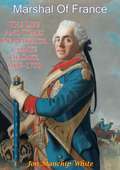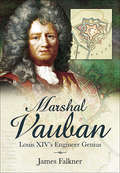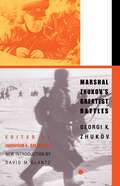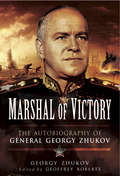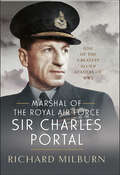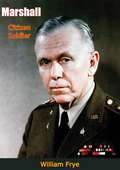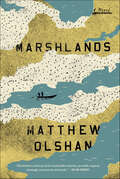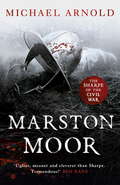- Table View
- List View
Married or Not?
by Annette BroadrickSTILL A HUSBANDGreg Hogan thought he'd achieved all his life's goals. Then everything changed when he received the call that his ex-wife had been injured. Though Sherri denied needing his help, Greg knew he couldn't turn her away. Impulse drove him to bring her back to his house, desire pushed him to act on the passion that still burned between them. Yet for Greg to keep Sherri in his home, his bed...his life, he'd have to risk revealing the secrets that had once torn them apart.
Married to Her Enemy: A Medieval Romance
by Jenni FletcherFrom captive to bride... Lady Aediva of Etton will do anything to protect her sister, Cille. So when enemies storm her family's keep, Aediva assumes Cille's identity...taking her place as prisoner of Sir Svend du Danemark. Svend's sole aim is to fulfill his service to William the Conqueror and rebuild the life a woman's betrayal once lost him. So when he receives his new orders to quash the Saxon rebellion, he is stunned. To do his duty, he must vow to take the beautiful yet provoking Aediva as his wife!
Married to the Military: A Survival Guide for Military Wives, Girlfriends, and Women in Uniform
by Meredith LeyvaNow revised to reflect the reality of military and economic unrest around the world, Married to the Military remains an invaluable resource for any military spouse or significant other.When you marry a military service member, whether a reservist or active—you may feel as if you&’ve also married the United States military! While there are plenty of orientation books on military training, there is not much information available about handling the personal aspects of military life. Married to the Military demystifies the often confusing military world so you can make the right choices for yourself and your family. Meredith Leyva, an experienced military wife and founder of CinCHouse.com, the Internet&’s largest community for military wives, girlfriends, and women in uniform, offers time-tested advice on everything you need to know—from relocation to deployment, protocol to finances, and career to kids, including: -Keeping your love life together during deployments -Relocating yourself and your family around the world -Maintaining your own career when you're expected to move every three years -Understanding what pay and benefits you're entitled to—and how to maximize them -Dealing with post-traumatic stress disorder (PTSD) and other threats to your partner&’s well-being Whether you&’re figuring out military protocol or trying to understand the medical system, this savvy, friendly yet authoritative guide details just what you need to know to manage day-to-day issues and get on with the adventure of military life.
Married to the Military: The Employment and Earnings of Military Wives Compared with Those of Civilian Wives
by Craig Martin C. Christine Fair James Hosek Beth J. Asch Michael MattockFocusing on military wives' contribution to family income, the authors find that, in contrast to civilian wives, military wives are willing to accept lower wages rather than search longer for jobs. They work less than civilian wives if they have young children but more if their children are older; are less probable to work as they get older; and respond to changes in the unemployment rate as workers with a permanent attachment to the work force, not as "added workers."
Marry Me, Major: Falling For The Venetian Billionaire (holiday With A Billionaire) / Marry Me, Major (american Heroes) (American Heroes Ser. #38)
by Merline LovelaceAn officer and a groom But for how long? Alexis Smith is single, and desperate to keep custody of her late sister’s sweet stepdaughter. But for this, she needs a husband. She thinks US Air Force Major Ben Kincaid is perfect for the job. The Special Ops pilot is a world-class stud who loves a challenge—and is always out of town. A brief marriage of convenience suits them both…until Ben moves in. Suddenly, playing house seems a little too real…
Marrying the Captain
by Carla KellyAn independent woman is drawn to a handsome naval captain—sent by her controlling father—in this delightful Regency romance.Ever since her father tried to sell her as a mistress to the highest bidder, Eleanor “Nana” Massie has prized her independence above all else—even if it means living in poverty. But her world changes overnight when Captain Oliver Worthy shows up at her struggling inn. Despite herself, Nana is intrigued by her beguiling gentleman guest . . . Oliver planned to stay in Plymouth only long enough to report back to Lord Ratliffe—about Nana. But he soon senses that Lord Ratliffe is up to something, and Oliver will do anything to keep this courageous, beautiful woman safe. He’d even go so far as to marry her!
Marrying the Royal Marine
by Carla KellyA young woman’s journey to help in the war against Napoleon brings her close to a brave and caring officer in this historical romance.As the illegitimate daughter of a nobleman, Polly Brandon has always felt like an ugly duckling. So she’s amazed when Lieutenant Colonel Hugh Philippe Junot pays her such close attention as they sail for Portugal. She knows this Royal Marine would never look at her under ordinary circumstances, but having his protection is more than a comfort . . . it is a pleasure.Hugh is immediately taken with the spirited beauty aboard his ship. Her determination to assist with the war effort is admirable, and when she falls ill, he feels compelled to care for her. But Polly still has trouble believing what she sees in Hugh’s eyes—that she has turned from an ugly duckling into a desirable swan . . .
Marsbound (Gateway Essentials #309)
by Joe HaldemanYoung Carmen Dula and her family are embarking on the adventure of a lifetime - they are going to Mars. But Carmen isn't so sure she wants to. After training for a year and preparing to leave on the six-month journey, she finds that the initial excitement has given way to both trepidation and frustration.Once there, however, Carmen realizes that things are not so different from Earth. There are chores, lessons, and oppressive authority figures. All of that leads her to venture out into the bleak Mars landscape alone, where an accident takes her to the edge of death - and she is saved by an angel. An angel with too many arms and legs, a head that looks like a potato gone bad - and a message for the newly arrived inhabitants of Mars:We were here first...
Marshal Ferdinand Foch, His Life and His Theory of Modern War
by Andrew Hillard AtteridgeA. H. Atteridge penned many books on the subject of warfare, concentrating mainly on the Napoleonic period and the German army in the run up to the First World War. War Correspondent of the Daily Chronicle in the Sudan campaign of 1896, he was also special correspondent at manoeuvres of various foreign armies, and was an officer in the London Irish Rifles from 1893 to 1905. Some of the important military works written by him included Towards Khartoum, Wars of the Nineties, Napoleon's Brothers, Joachim Murat, and Marshal Foch. An acknowledged expert, his writing style is fluid and pacy without losing any of his authoritative knowledge.In this volume, the author focusses on the celebrated Marshal Ferdinand Foch: Atteridge documents Foch's rise from military theorist of high repute before the First World War to the pinnacle of command as the general in chief of the entire war effort. Not a dry analysis of dates and figures, the entire methodology of Foch's theory of warfare is discussed; from the foundations from Foch's time at the Ecole de Guerre to the application of them against the invading forces of Germany.Still an excellent biography of the leader of the Allied Generallisimo.Author- Andrew Hilliard Atteridge (1844-1941)Text taken, whole and complete, from the edition published in New York, Dodd, Mead and company, 1919.Illustrations -- 8 maps.Original Page Count - 286 pages.
Marshal Jean Lannes In The Battles Of Saalfeld, Pultusk, And Friedland, 1806 To 1807: The Application Of Combined Arms In The Opening Battle
by Major Robert E. EversonThe French Army corps during the Napoleonic era was a combined arms organization, designed as a self-sustaining combat unit which could operate independently from the rest of the army. One corps was designated as the advanced guard to the French army's main body and acted as the unit which would make first contact with the enemy's army. This corps developed the situation while other corps would attempt to maneuver to the rear of the enemy force and consequently fight a major battle under Napoleon's control.The advanced guard corps which made first contact, would fight an opening battle which could last many hours until reinforcements arrived. The corps under Marshal Lannes in 1806 to 1807 fought three opening battles. During each battle the corps conducted their security and reconnaissance while moving towards the enemy, seized their initial positions on the impending battlefield and fought as a combined arms organization for the duration of the opening battle.This study shows how each of the branches; artillery, infantry, and cavalry, interacted in the opening battle. This study also reveals how Marshal Lannes established a combined arms advanced guard element within his corps each time he moved the corps as the advanced guard for the French Army. Although this advanced guard element was not a doctrinal organization for the French Army, the elements mission was strikingly similar to the larger corps acting as an advanced guard, but on a reduced scale.
Marshal Joffre: The Triumphs, Failures and Controversies of France's Commander-in-Chief in the Great War
by André BourachotA century ago General Joffre, as Chief of the French General Staff, led the armies that blocked the German invasion at the First Battle of the Marne. He saved Paris from occupation and France from probable defeat. His calm demeanour when faced with a disaster, his ruthless dismissal of incompetent subordinates, and his skilled redeployment of his forces contributed to a historic victory. At the time many saw him as the saviour of the nation, but what should we make of him now? For Joffre contributed to the failures of the French army and its strategy before the war and during the first battles of 1914. Also his conduct of the war after the Marne futile offensives that cost thousands of lives and gained no ground, followed by near defeat at Verdun - undermined his position and led to his dismissal.Although he remained immensely popular in France, his reputation has been under a cloud ever since, and he has been overshadowed by the French generals - Ptain and especially Foch - who commanded the French army at the time of the final victory over Germany.Andr Bourachot, in this lucid and highly readable study of Joffre's career, focuses on his performance during the opening phase of the Great War. He offers a fresh and carefully considered view of the man and the soldier.
Marshal Louis N. Davout And The Art Of Command
by Major John M. KeefeThis paper involves an in-depth study of the art of command at all three levels of warfare. It examines this art through the eyes of one of Napoleon's ablest Marshals, Louis N. Davout. The paper addresses and accomplishes three primary goals. First, it defines the art of command and shows its relevance to modern day warfare. Second, the paper shows that Marshal Davout was the best of Napoleon's generals and had an art of command that rivaled the Emperor himself. Finally, the paper demonstrates how Davout was instrumental in winning the battle of Abensberg-Eckmühl.The study proves that Marshal Davout displayed an art of command at Abensberg-Eckmühl that ensured success for Napoleon during the early phases of his Austrian campaign of 1809. It does this through a detailed analysis of his actions throughout the five days of fighting from April 19 to April 23, 1809. The study then draws conclusions to help define the art of command from Davout's actions.
Marshal Ney - Bravest Of The Brave: Michel Ney, Marshal Of France, Duke Of Elchingen, Prince Of The Moskowa, 1769-1815 (1912)
by Pickle Partners Publishing Andrew Hilliard AtteridgeThis ebook is purpose built and is proof-read and re-type set from the original to provide an outstanding experience of reflowing text for an ebook reader. Few of Napoleon's Marshals have been involved in such controversy as the son of a cooper from Sarrelouis, Michel Ney. His reputation has been argued over fiercely by military historians, Bonapartists, revisionists and romantics for almost two centuries since his untimely demise at the hands of his own countrymen in the gardens of the Luxembourg. This volume paints a sympathetic picture of Marshal Ney, drawing on the memoirs of his subordinates and Général Bonnal's Vie Militaire du Maréchal Ney to combine into the best single volume biography yet published in English. Atteridge writes concisely but vividly, and does not shy away with the controversies that have dogged Ney's reputation, whilst providing a clear framework of the events. The details are accompanied by numerous maps, including excellent details on the often overlooked Battle of Hohenlinden in 1800 which secured the French Republic. From the early days of the French Republic, Ney fought fiercely and with much skill, through to the dark days of the retreat from Russia in 1812 in which he saved the remnants of the vast army Napoleon led to their destruction. His actions in the Hundred Days, for which he lost his life in a trial whose outcome was predetermined, are analyzed clearly and he deserved a better lot than he received for his efforts. Ney was a pivotal figure in an era of giants and Atteridge's book does him the justice his brave and valorous character demands. Highly recommended. Atteridge's book forms a companion to his other single volume biography of Marshal Murat and his work on the varied personalities on Napoleon's Brothers. Text taken, whole and complete, from the 1912 edition, published in London by Metheun and Co. Ltd. Original - 468 pages. Author- Andrew Hilliard Atteridge (1844-1912) Linked TOC and 8 Illustrations and 8 maps.
Marshal Ney At Quatre Bras: New Perspectives on the Opening Battle of the Waterloo Campaign
by Paul L. DawsonFought on 16 June 1815, two days before the Battle of Waterloo, the Battle of Quatre Bras has been described as a tactical Anglo-allied victory, but a French strategic victory. The French Marshal Ney was given command of the left wing of Napoleons army and ordered to seize the vital crossroads at Quatre Bras, as the prelude to an advance on Brussels. The crossroads was of strategic importance because the side which controlled it could move southeastward along the Nivelles-Namur road.Yet the normally bold and dynamic Ney was uncharacteristically cautious. As a result, by the time he mounted a full-scale attack upon the Allied troops holding Quatre Bras, the Duke of Wellington had been able to concentrate enough strength to hold the crossroads.Neys failure at Quatre Bras had disastrous consequences for Napoleon, whose divided army was not able to reunite in time to face Wellington at Waterloo. This revelatory study of the Waterloo campaign draws primarily on French archival sources, and previously unpublished French accounts, to present a balanced view of a battle normally seen only from the British or Anglo-Allied perspective.
Marshal Of France; The Life And Times Of Maurice, Comte De Saxe, 1699-1750
by Jon Manchip WhiteMAURICE DE SAXE was the brilliant adornment of a brilliant age, one of the most renowned and admired men in the Europe of his day. It is not surprising that the writing of the biography of this vivid, talented and entertaining figure should have provided the author with a genial and absorbing task.He came of extraordinary stock; the circumstances of his birth were remarkable; he was the lover of many celebrated women; he won the lifelong friendship of men of the stature of Voltaire; he aspired to a crown, and nearly became the Czar of Russia; his activities spanned a whole continent, from Paris to Dresden, from Dresden to Warsaw, from Warsaw to Moscow. Yet he was more, much more, than an energetic and flamboyant adventurer: he was acknowledged to be the outstanding general of his era, a military genius who linked the epoch of Marlborough with the epoch of Frederick the Great. He led great armies and won great victories.It is part of the purpose of this book to restore him to the pre-eminent place in social and military history to which his achievements entitle him. The study of his campaigns has proved no dutiful or dreary labour, for he was among the wittiest and most elegant military practitioners who have ever lived. There was a touch of diablerie about the manner in which he gained his spectacular triumphs that set him apart from the other great captains of his era.
Marshal Vauban: Louis XIV's Engineer Genius
by James Falkner&“[A] vivid and well written account of the life of the man who built some of the most magnificent military structures known to man.&”—Clayton Donnell, &“Fortress Archaeologist&” Sebastien Le Prestre, Marshal Vauban, was one of the greatest military engineers of all time. His complex, highly sophisticated fortress designs, his advanced theories for the defense and attack of fortified places, and his prolific work as a writer and radical thinker on military and social affairs, mark him out as one of the most influential military minds of the late seventeenth and early eighteenth centuries. Yet no recent study of this extraordinary man has been published in English. James Falkner, in this perceptive and lively new account of Vauban&’s life and work, follows his career as a soldier from a dashing and brave young cavalry officer to his emergence as a masterful military engineer. And he shows that Vauban was much more than simply a superlative builder of fortresses, for as a leading military commander serving Louis XIV, he perfected a method for attacking fortifications in the most effective way, which became standard practice until the present day. Falkner&’s new study will add significantly to the understanding of Vauban&’s achievements and the impact his work has had on the history of warfare. &“A very enjoyable read for those looking for a good, basic account of Vauban&’s career and his role in the wars of Louis XIV and of fortification more generally. Its usefulness is enhanced by various maps and reproductions of portraits of key characters and of contemporary plans of fortresses.&”—War in History
Marshal Vauban: Louis XIV's Engineer Genius
by James Falkner&“[A] vivid and well written account of the life of the man who built some of the most magnificent military structures known to man.&”—Clayton Donnell, &“Fortress Archaeologist&” Sebastien Le Prestre, Marshal Vauban, was one of the greatest military engineers of all time. His complex, highly sophisticated fortress designs, his advanced theories for the defense and attack of fortified places, and his prolific work as a writer and radical thinker on military and social affairs, mark him out as one of the most influential military minds of the late seventeenth and early eighteenth centuries. Yet no recent study of this extraordinary man has been published in English. James Falkner, in this perceptive and lively new account of Vauban&’s life and work, follows his career as a soldier from a dashing and brave young cavalry officer to his emergence as a masterful military engineer. And he shows that Vauban was much more than simply a superlative builder of fortresses, for as a leading military commander serving Louis XIV, he perfected a method for attacking fortifications in the most effective way, which became standard practice until the present day. Falkner&’s new study will add significantly to the understanding of Vauban&’s achievements and the impact his work has had on the history of warfare. &“A very enjoyable read for those looking for a good, basic account of Vauban&’s career and his role in the wars of Louis XIV and of fortification more generally. Its usefulness is enhanced by various maps and reproductions of portraits of key characters and of contemporary plans of fortresses.&”—War in History
Marshal Zhukov at the Oder: The Decisive Battle for Berlin
by Tony TissierOn 31 January 1945, in the dying months of the Second World War, the first Red Army troops reached the River Oder, barely 40 miles from Berlin. Everyone at Soviet Headquarters expected Marshal Zhukov’s troops to bring the war quickly to an end. Despite bitter fighting by both sides, a bloody stalemate persisted for two months until the Soviet bridgeheads north and south of Küstrin were united and the Nazi fortress finally fell.Marshal Zhukov at the Order is an impressively detailed account of the Nazi–Soviet battles in the Oderbruch and for the Seelöw Heights, east of Berlin. They culminated in April 1945 with the last major land battle in Europe that proved decisive for the fate of Berlin – and the Third Reich. Drawing on official sources and the personal accounts of soldiers from both sides who were involved, Tony Le Tissier has reconstructed the Soviets’ difficult breakthrough on the Oder, documenting the final death throes of Hitler’s Thousand-Year Reich.
Marshal Zhukov's Greatest Battles
by Georgi K. Zhukov Theodore Shabad Harrison E. SalisburyHistory of 4 of Zhukov's battles during WWII: The Battle of Moscow, the Battle of Stalingrad, the Battle of Kursk, and the Battle of Berlin
Marshal Zhukov's Greatest Battles
by Georgi K. ZhukovConsidered by some to be the greatest general of World War II, General Georgi Zhukov served as the Chief of Staff of the Soviet High Command, leading Soviet troops against Germans in key battles of the war. In his account of four major campaigns in the war—the defense of Moscow, Stalingrad, and Kursk, and the advance on Berlin—Zhukov describes his experiences preparing for German attacks, organizing counter-strikes, assessing the enemy, and issuing the orders that pushed the front west, towards Germany's capital. Zhukov also tells of his extensive arguments with Stalin during the war, and the political alliances and rivalries among the U. S. S. R.'s generals throughout the conflict.
Marshal of Victory: The Autobiography of General Georgy Zhukov
by Geogry ZhukovThe complete and unredacted autobiography by Stalin’s star general, chronicling his many campaigns throughout WWII.At Moscow, Leningrad, Stalingrad, Kursk and Berlin—as well as virtually all the principal battles on the Eastern Front during the Second World War—Georgy Zhukov played a major role. He was Stalin’s pre-eminent general throughout the conflict, and he chronicled his brilliant career as he saw it in this essential text.Here, Zhukov reveals intriguing insights into who he was, both as a man and as a commander. He also delves into the military thinking and decision-making at the highest level of the Soviet command—making this volume essential reading for anyone studying the conflict in the east.This edition of the memoirs, which were first published in heavily censored form, features an introduction by Professor Geoffrey Roberts in which he summarizes the additional material omitted from previous editions. He also provides, in an appendix, a translation of Zhukov’s account of the 1953-7 period as well as an interview with Zhukov that has previously not been available in English.
Marshal of the Royal Air Force Sir Charles Portal: One of the Greatest Allied Leaders of WW2
by Richard Michael MilburnCharles Frederick Algernon Portal was born in Hungerford, England, in 1893. One of seven brothers, Portal developed a fierce competitive streak and a steely determination from an early age. Known by all who knew him as ‘Peter’, Portal enlisted in the Army at the outbreak of the First World War as a dispatch rider, being mentioned in General French’s very first dispatch. Portal’s abilities were quickly recognized, and he gained a commission in short order. It was in the air that Portal saw his future, and he subsequently transferred to the Royal Flying Corps, initially as an observer, before training as a pilot. In this latter role, Portal proved a courageous and instinctive leader, garnering the rare accolade of a DSO and Bar for his wartime service. His meteoric rise continued in the inter-war period, and when Hitler’s forces invaded Poland, Portal had already ascended to the Air Force Board. He then took the RAF’s top command post at Bomber Command during the battles of France and Britain, before replacing Cyril Newall as Chief of Air Staff, aged just 47, in October 1940. Charles Portal was, in General Eisenhower’s words, ‘Britain’s greatest wartime leader, including Churchill’. Portal was a strategist, a diplomat and an outstanding leader of the RAF in the Second World War. He built productive and enduring relationships with the most powerful Allied leaders – some of which, including Churchill, Bomber Harris, and Hap Arnold, are explored here. Portal helped direct the UK’s strategy from the darkest days of 1940 through to Allied victory in 1945. He never lost his calm, even under the most extreme pressure, and approached the war with a cool logic that defied the chaos of the day. Despite his enormous achievements, and being showered with post-war accolades, Portal is little known today. His historical anonymity is a reflection of his disinterest in his own legacy. He neither kept wartime diaries, nor penned an egotistical autobiography to cash in on his post-war fame. He retired as he had served, with dignity and humility, traits that made him particularly influential with American allies. As Wing Commander Rich Milburn reveals in this long-overdue second biography, Charles Portal was a hero in every sense; a heroic battlefield leader in one global conflict, and one of the men most directly responsible for Allied victory in a second.
Marshall: Citizen Soldier
by William FryeIf you think of biography as the static record of a man’s achievement, compiled during twenty or more mellowing years, William Frye’s book will have the impact of an electric shock. Marshall: Citizen Soldier is not to be leafed through idly, just as George Catlett Marshall himself cannot be regarded passively.That deceptively mild manner of his, as buck privates, brass hats and not a few politicos have discovered, only indifferently conceals a driving determination, backed by an inner steel core of moral integrity and joined with a lifetime’s habit of command.The general public has not given Marshall the excited, short-lived adulation that it has heaped upon more flamboyantly dramatic military men. But the people recognized in George Marshall the citizen’s soldier to whom they could safely entrust the most vital post in an America at war—Chief of Staff of the United States Army.The acceptance by Marshall early in 1947 of one of the greatest appointive offices in our government, that of Secretary of State, a job today of world significance, leaves no doubt either of the abilities of the man or of his devotion to the public weal. For the dearest wish of the erstwhile Chief of Staff had been a quiet retirement at the end of his Army duties.Marshall began his career in unorthodox fashion by graduating from the V.M.I. instead of West Point. Even on routine tours of duty in the Philippines, in the States and later in China he was singled out by senior officers as a young man of remarkable ability. During World War I, Marshall asked for command duty in France. His superiors rushed him abroad but they realized that Major Marshall was hard-to-get staff officer material, not slated for a regular front-line assignment.William Frye as Marshall’s biographer comes into touch with some of the knottiest questions of the war years. He does not sidestep issues and controversies; he meets them with decision.
Marshlands: A Novel
by Matthew Olshan"A first novel of considerable maturity: powerful, original, cunningly constructed, and timely." —Julian Barnes, author of The Sense of an EndingAfter years alone in a cell, an aging prisoner is released without explanation, expelled into a great city now utterly unfamiliar to him. Broken by years of brutality at the hands of the prison guards, he scrounges for scraps, sleeping wild, until a museum curator rescues him from an assault. The museum has just opened its most controversial exhibit: a perfect replica of the marshes, an expansive wilderness still wracked by conflict. There the man had spent years as a doctor among the hated and feared marshmen, who have been colonized but never conquered. Then Marshlands reveals one of its many surprises: it is written in reverse. The novel leaps backward once, twice, returning to the marshes and unraveling time to reveal the doctor's ambiguous relationship to the austerely beautiful land and its people. As the pieces of his past come together, a great crime and its consequences begin to take shape. The true nature of the crime and who committed it will be saved for the breathtaking ending—or, rather, for the beginning. In the tradition of Wilfred Thesiger's The Marsh Arabs and J. M. Coetzee's Waiting for the Barbarians, Marshlands explores a culture virtually snuffed out under Saddam Hussein, and how we cement our identities by pointing at someone to call "other." Elegant, brief, and searing, Matthew Olshan's Marshlands shivers with the life of a fragile, lost world.
Marston Moor: Book 6 of The Civil War Chronicles (Stryker)
by Michael ArnoldThe Sixth in The Civil War Chronicles featuring Major Stryker - 'the Sharpe of the Civil War'FIVE ARMIES FORTY-SIX THOUSAND MEN ONE CROWNTHE BIGGEST BATTLE OF THE AGE2 July 1644. Five armies converge outside York. It will be a battle for honour, glory, and the fate of three kingdoms. And it will pit two great leaders - Oliver Cromwell and Prince Rupert - directly against one another for the first time. It is a day that will change the course of history.Into the cannon fire and musket smoke marches Major Innocent Stryker, battle-scarred hero of the Royalist cause. He must not only lead his men through the bloody horror and outwit his Parliamentary enemies, but uncover foul treachery on his own side. He will need every shred of experience and determination to survive.Marston Moor will be the decisive turning point in the British Civil Wars.This is the thrilling and shocking story of that battle.



